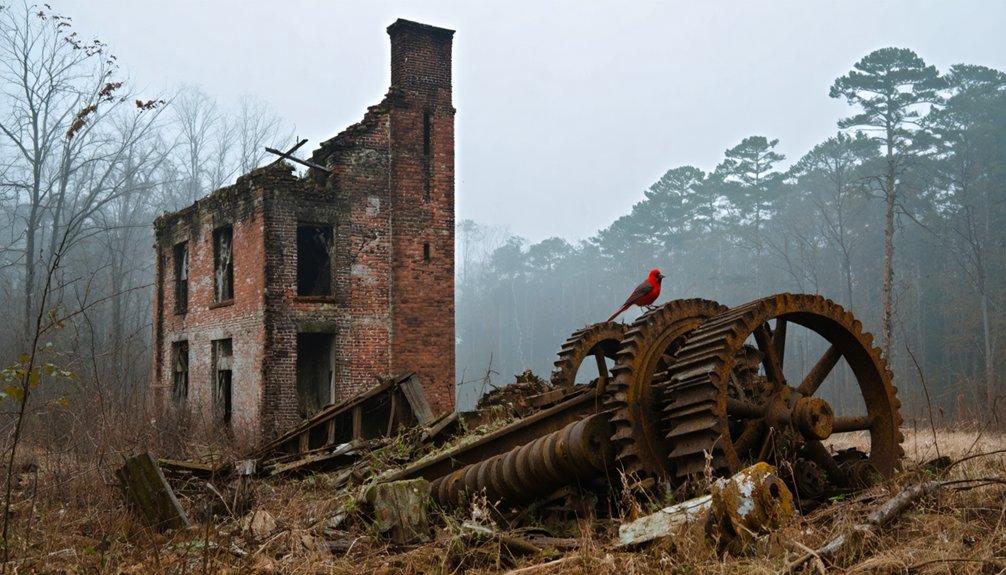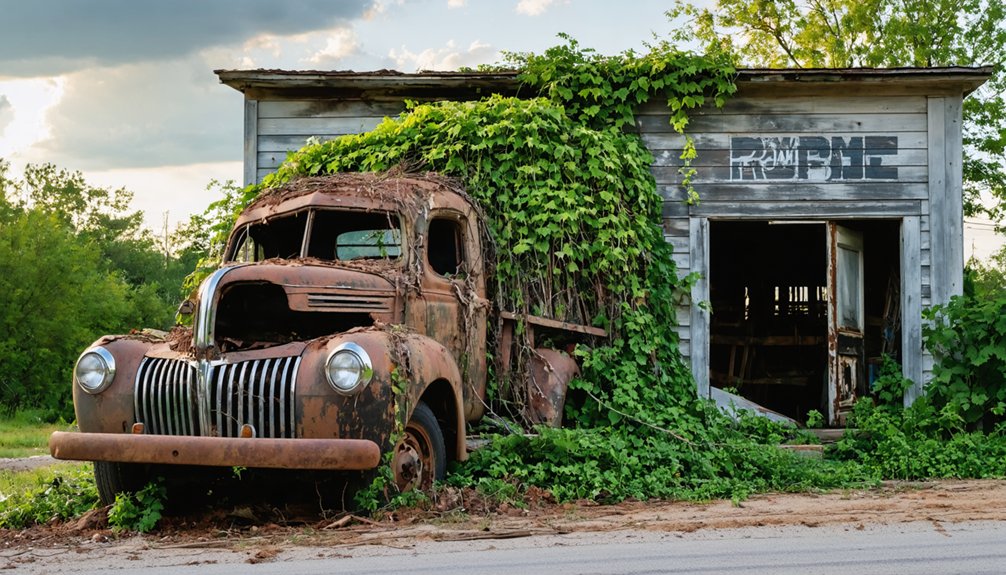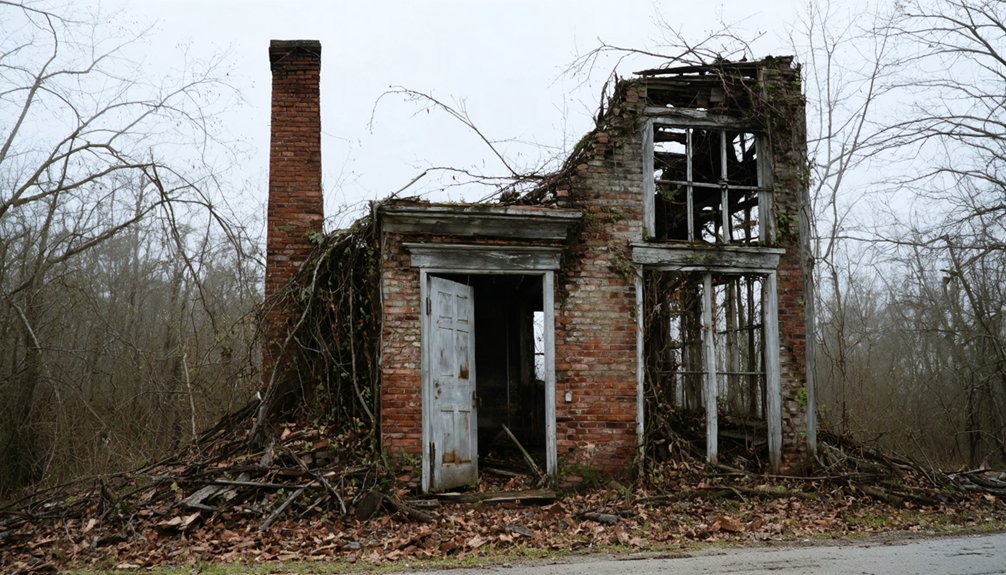You’ll find Beaver Mills as a ghost town in Mobile County, Alabama, near U.S. Route 45. Once a thriving industrial center, it operated as both a paper mill and Confederate uniform depot during the Civil War. The site featured integrated operations including corn and saw mills, powered by a dam system. Today, nature has reclaimed the area, leaving only stone walls and scattered Civil War artifacts to reveal its fascinating transformation from industrial powerhouse to forgotten settlement.
Key Takeaways
- Beaver Mills was a thriving industrial hub in Mobile County, Alabama, centered around paper production and mill operations.
- The site served as a Confederate uniform depot during the Civil War from 1861-1865, showing its strategic importance.
- The community’s post office operated as “Beaver Meadow” from 1890 to 1906, marking its peak period of activity.
- Stone walls and scattered Civil War uniform buttons remain as physical evidence of the town’s industrial and military past.
- The site is now a ghost town reclaimed by nature, with restricted access due to removed bridges and private property status.
The Rise of a Paper Mill Empire
During the late 19th century, Beaver Mills emerged as a significant industrial hub in Mobile County, Alabama, establishing itself near what would later become U.S. Route 45.
A pioneering industrial complex in Mobile County, Beaver Mills transformed Alabama’s manufacturing landscape near modern-day Route 45.
You’ll find this remarkable site situated at coordinates 30° 58′ 11″ N, 88° 14′ 05″ W, where industrial innovation transformed the local landscape.
The complex’s paper production facilities weren’t just limited to traditional paper manufacturing. You could witness the integration of multiple operations, including corn and saw mills, all powered by an ingeniously constructed dam and raceway system.
After the Civil War, the mill showcased its adaptability by converting military uniforms into bonded paper. The mill supported Confederate troops through its operations as both a paper mill and uniform depot.
The site’s technological advancement, marked by modern machinery for its time, helped establish Beaver Mills as a cornerstone of Alabama’s early industrial development, drawing workers and fostering community growth around its operations. Today, only the mill and stone walls remain as testament to this once-thriving industrial center.
Civil War Legacy and Military Connection
While many Southern industrial sites played essential roles in the Civil War, Beaver Mills gained strategic importance as a uniform depot for Confederate forces between 1861-1865.
The paper mill’s infrastructure underwent industrial repurposing to serve military logistics needs, storing and processing soldiers’ clothing. You’ll find evidence of this wartime connection in surviving stone walls and artifacts like uniform buttons that remain at the site today. To avoid confusion with other locations, modern historians refer to this site as Beaver Mills, Alabama when documenting its Civil War history.
- Colonel E. M. Hudson’s leadership helped coordinate local wartime activities
- The site’s location near transportation routes made it ideal for supply distribution
- Post-war, military uniforms were converted into paper products
- Archaeological remains reveal the depot’s role in Confederate supply chains
The depot’s strategic position near Route 45 and railroad access made it a significant node in the South’s military logistics network.
Life in a One-Industry Town
Life in Beaver Mills revolved entirely around the paper mill’s daily rhythms, where you’d find most residents employed in various aspects of paper production.
You wouldn’t have found much economic diversity here – when the mill thrived, the town thrived, highlighting both the community’s resilience and its economic vulnerability.
The town’s infrastructure supported this single-industry focus, with a post office operating under the name “Beaver Meadow” from 1890 to 1906 serving the mill workers and their families.
Your daily social activities would’ve centered around mill-related events and your neighbors who shared the same workplace.
This tight-knit community structure worked well while the paper industry flourished, but when the mill began to decline, you’d have watched the town’s liveliness fade along with it.
During the Civil War, the mill played a crucial role as a uniform depot that later repurposed military uniforms into paper products.
Today, only remnants hidden in woods remain of this once-bustling industrial site.
Natural Reclamation and Current State
As time marches forward, nature has steadily reclaimed the remnants of Beaver Mills, leaving only the paper mill’s stone walls standing like castle ruins in the dense Alabama woods.
The structural remains tell a story of abandonment, with vegetation overgrowth transforming the once-bustling town into an untamed wilderness.
Today, you’ll find:
- Civil War-era uniform buttons scattered among the leaf litter
- Swampy terrain and humid conditions that accelerate natural decay
- Dense hardwood forests where buildings once stood
- Stone walls of the mill rising through thick undergrowth
You can’t freely access the site anymore – bridges have been removed and the property is private.
The hot, humid climate has helped nature erase most traces of human habitation, except for those enduring stone walls that refuse to surrender to time.
Historical Significance and Cultural Impact
Though its stone walls now stand silent, Beaver Mills played a crucial role in Alabama’s industrial and wartime history.
The nature and parks surrounding the area add to the historic atmosphere, creating a serene backdrop for visitors exploring the ruins.
You’ll find evidence of its industrial heritage in the remnants of the paper mill that once sustained a thriving community. During the Civil War, the mill transformed into a uniform depot, showcasing the community’s resilience and adaptability in supporting Confederate forces.
The town’s legacy extends beyond its physical ruins. You can still discover Civil War uniform buttons scattered across the site, tangible connections to its wartime past.
Metal buttons scattered among stone ruins tell silent stories of soldiers who once gathered here.
As one of Mobile County’s ghost towns, Beaver Mills represents the broader story of single-industry communities throughout Alabama – their rise during industrialization, their essential contributions during wartime, and their eventual decline as economic conditions shifted.
Frequently Asked Questions
Were There Any Reported Ghost Sightings or Paranormal Activities at Beaver Mills?
You won’t find any ghost legends or paranormal investigations at this site – historical records and local folklore don’t mention supernatural activities, and no credible eyewitness accounts exist in documented archives.
What Was the Average Wage for Paper Mill Workers in Beaver Mills?
You won’t find specific wage data for Beaver Mills workers, but comparing labor conditions with modern Alabama paper mill wages ($16.62/hour average) gives you a sense of historical compensation patterns.
Did Any Notable Historical Figures Ever Visit the Beaver Mills Site?
You won’t find any documented visits from famous figures at this site. Despite its historical significance during the Civil War, no credible visitor accounts exist of notable people exploring these grounds.
What Other Industries or Businesses Existed Besides the Paper Mill?
You’ll find no evidence of cotton production or timber trade – just a uniform depot during the Civil War, bonded paper production using surplus clothing, and a post office operating from 1890-1906.
How Many Confederate Uniforms Were Processed at the Depot During Wartime?
You’ll find no specific records of Confederate uniform quantities at Beaver Mills depot. While it supported regional distribution, the exact processing numbers weren’t documented, unlike Montgomery’s 22,000 annual uniform production.
References
- https://kids.kiddle.co/Beaver_Mills
- https://raregoldnuggets.com/?p=3894
- https://digitalalabama.com/places-to-see-in-alabama/beaver-mills-alabama-ghost-town/
- https://www.ghostlyworld.org/place-city/al-beaver-mills/
- https://digitalalabama.com/alabama-ghost-towns/beaver-mills-alabama/2921
- https://www.ghosttowns.com/states/al/beavermills.html
- https://www.ghostlyworld.org/places/beaver-mills-alabama/
- https://en.wikipedia.org/wiki/List_of_ghost_towns_in_Alabama
- https://digitalalabama.com/alabama-counties/mobile-county-alabama/beaver-mills-alabama/2921/
- https://discoverstclair.com/st-clair-cooking/beaver-creek-gristmills-cornbread-and-memories/



